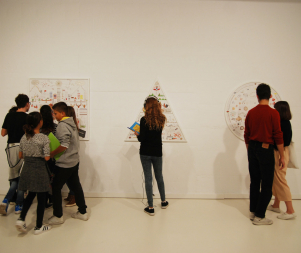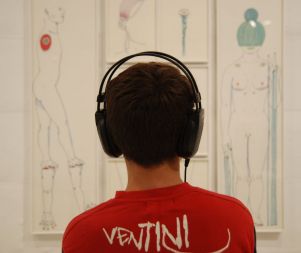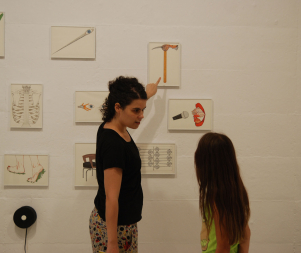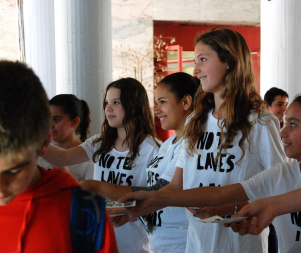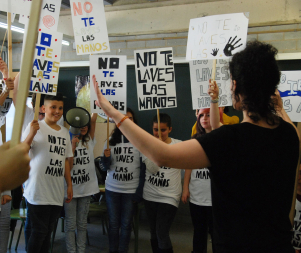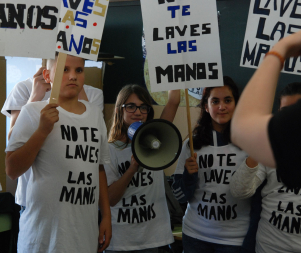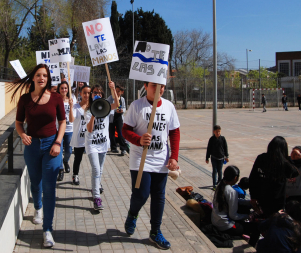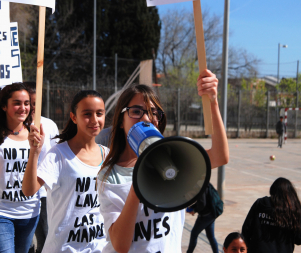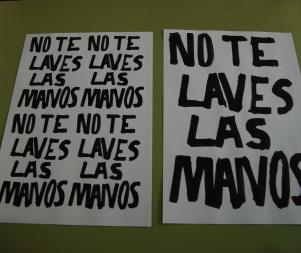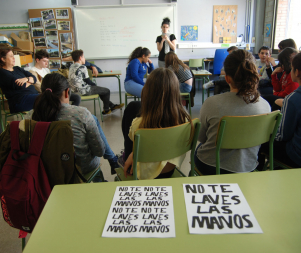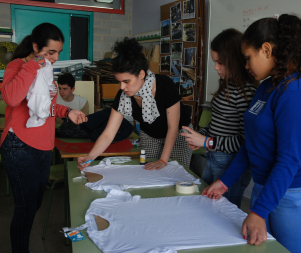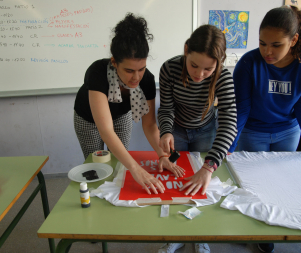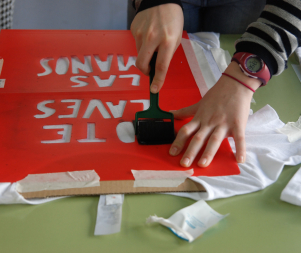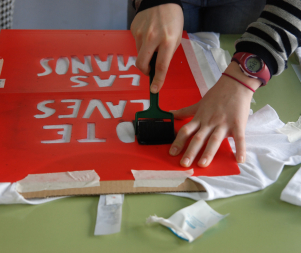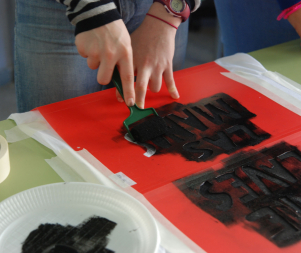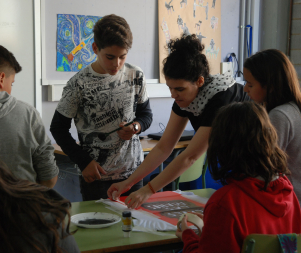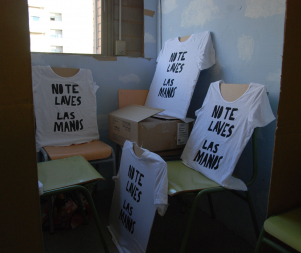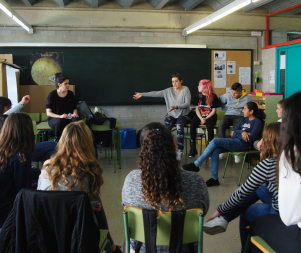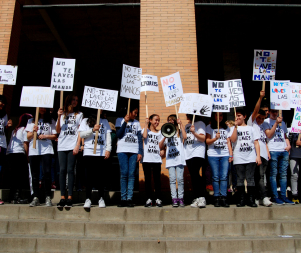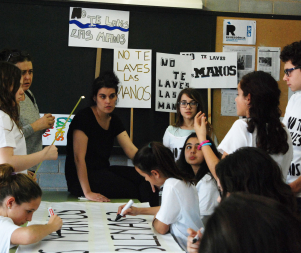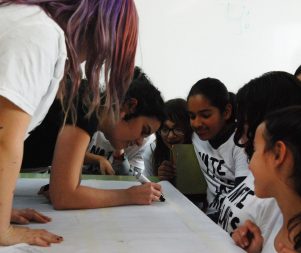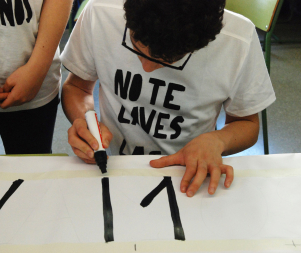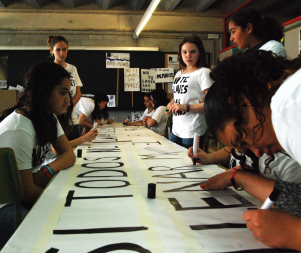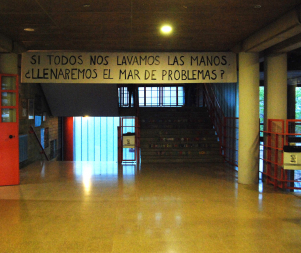- 14th EDITION 2022 / 2023
- 13th EDITION 2021 / 2022
- 12th EDITION 2020 / 2021
- 11th EDITION 2019 / 2020
- 10th EDITION 2018 / 2019
- 9th EDITION 2017 / 2018
- 8th EDITION 2016 / 2017
- 7th EDITION 2015 / 2016
- 6th EDITION 2014 / 2015
- 5th EDITION 2013 / 2014
- 4th EDITION 2012 / 2013
- 3rd EDITION 2011 / 2012
- 2nd EDITION 2010 / 2011
- 1st EDITION 2009 / 2010
Ana Garcia-Pineda IN RESiDENCE at the School Doctor Puigvert
Discovering the world of Ana García-Pineda: visit to La ficción es una realidad por suceder [Fiction is a Reality Yet to Happen]
In order to discover the world of Ana García-Pineda at first hand, a visit is organised to Fundació Joan Miró, where the artist is presenting a solo exhibition. The visit is divided into two parts: first, discovering of the pieces on show (drawings and audios); and, secondly, shared thought and discussion about the ideas, feelings and discoveries generated by the visit.
This led to the initial meditation on the importance of different uses of language (irony, synaesthesia, with discussion of the distance between literal and figurative meaning) and its link with the visual.
Text creation: fictional worlds
Following the visit to the exhibition, the group begins a process of creating texts in the manner of Ana García-Pineda: texts that, through the elimination of a rule or law, create possible worlds. Before writing the texts, the pupils spent several weeks studying the artist’s own texts.
The absurd, the surreal, irony and so on – all are points of reference. What are Ana García-Pineda’s points of reference? The work sessions begin with discussion or by viewing the work of a selection of writers related to these themes. This enables the group to discover surrealism and the absurd as expressive possibilities.
The absurd and questions without answer
Discover and study of chindogus, absurd gadgets created to resolve everyday needs... The discovery continues with a recreation of the process: detecting needs, difficulties and problems to be resolved, and inventing absurd devices that, apparently, are the solution to them. This process sees the introduction of a collective way of working through brainstorming and chains of ideas.
Unanswered questions arise. Based on “problems” detected, the work proposal revolves around the interrogative voice. Can we open up possible meanings even more by asking a question? Is there any possibility of multiplying the possibilities of meaning? What would be the use of language in this case? This work begins at this point in the course but becomes a constant until the end of the academic year.
One of the questions is growing in strength...
Conception of the performance No te laves las manos [Don’t wash your hands]. The meaning of this idiomatic expression is analysed, and a performance is conceived to highlight the distance between its literal sense and its figurative meaning... The group begins to produce the materials to stage a performance in two acts at the school to demonstrate this distance.
Action and thought
The performance is staged over two consecutive days: a performance is staged in the school playground in which the group of pupils demonstrate with the slogan. Next, they put up posters all over the school, and hand out flyers. In the afternoon, when there are no pupils at the school, a poster is installed in the lobby with the question “If we all wash our hands, will the world be a sea of problems?” in order observe the reactions and thoughts of their fellow-pupils.
A circular text based on one of the questions without answer
The questions without answer are very much present in the classroom and in the work process. In fact, the group continues to work on them in order to create a circular text. The starting point is one of the questions: Where does the light go when it goes? (“¿Dónde va la luz cuando se va?”). This question will also give its name to one of the final pieces. The pupils read the text aloud, and this is recorded in order to make an audio.
Designing an exhibition
Organising a show involves studying the exhibition space. The group visits Baró de Viver community centre in order to see the spaces and take measurements. After the visit, they build a model to work on in the classroom and decide how the three pieces presented should be arranged in order to form a single unit.
Assembly and presentation
The exhibition No necesitas una apisonadora si tu lógica es aplastante [You Don’t Need a Steamroller When Your Logic is Overwhelming] is presented at Baró de Viver community centre at 7.30 pm on June 6. The pupils, with the teacher, Mercè Gaja, and Ana García-Pineda, present the works and describe the work process. The event is attended by schoolmates and families, teachers and representatives from Barcelona Institute of Culture and Barcelona Education Consortium, as well as people linked to the world of culture.
Guided tours
Small groups of pupils organise guided visits for students taking the same course at the secondary school. During these visits, the pupils explain the works on show and describe the creative process.
Parallel activities
- Visit to the exhibition La ficción es una realidad por suceder [Fiction is a Reality Yet to Happen] at Fundació Joan Miró (18/10/2016)
A visit is organised for a session at the exhibition that Ana García-Pineda is presenting in Espai 13 at the Fundació Joan Miró. The session is organised so that the pupils have time to see and listen to the pieces before having a long, intense discussion with the artist and teachers about their initial sensations and the ideas generated by this first contact with the work.
- Visits to Baró de Viver community centre (several sessions)
In order to decide the arrangement of the works in the exhibition space, the group visits Baró de Viver community centre to take measurements and do more precise work using a model. After this first visit, a whole day is also devoted to assembling the show. Finally, in small groups, the pupils show the work to others in the same course in small guided tours.

